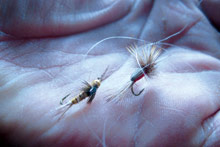I was in seventh grade when I caught my first trout on a fly, using a royal coachman. Lee Wulff, the warrior god of modern fly-fishing, improved on this classic pattern, substituting hair for wings and tail (to make it more buoyant, durable and easier to see in rough water) and dubbing it the royal Wulff. This is arguably the most popular (and successful) trout pattern in America, even though it doesn’t really imitate any insect; Wulff himself said it more closely resembles strawberry shortcake. The royal Wulff is great by itself, but it really shines as the upper fly when an angler rigs a “dropper.”

A dropper is a two-fly combination that’s fished together. For example, you might tie a royal Wulff onto the end of the tippet, as usual, and then tie a roughly 16-inch-long piece of 6x tippet to the hook of this upper fly, extending back to a larval imitation such as a pheasant tail or a gold-ribbed hare’s ear. This enables the angler to receive strikes on either the surface or the subsurface fly. The upper fly also acts as a strike indicator when a fish hits the nymph trailing below.
I would love to be able to catch fish on a nymph without any strike indicator, but it takes the concentration of a Zen master to pull off this feat. It’s hard enough to set the hook in the split second between a strike and when the fish realizes the fly isn’t food and spits it out. I’ve never had the patience to forgo catching fish while I master the subtleties of nymph fishing without a dropper rig.
The problem with rigging a dropper setup is that it requires three knots: the tippet-to-top fly, the hook to the piece of 6x, and the 6x to the trailing nymph. And this typically needs to be done in marginal light conditions, when a cold breeze has just kicked up, the fish are rising and time’s a-wasting—all while relying (in my case, anyway) on failing, middle-aged eyesight to guide this close, repetitive work. It can take me anywhere from 10 minutes to oh-to-hell-with-it, depending on the reigning combination of nonconducive streamside conditions.
My solution has been to rig droppers in advance at the kitchen table, where I have plenty of light and leisure. So when I’m fishing and want to change to a dropper, I have to tie only one knot (from the fly-line tippet to the top fly). Rigging a bunch of droppers in a controlled environment also improves your knot-tying ability for when you’re on the stream.
Convenience aside, carrying pre-rigged droppers also lets me assemble a number of different combinations matching what I expect to see hatching. The first Sunday in April, I rigged a Charlie whomper dragging a sheep fly behind, because Rich Witt‘s Xpress hatch guide told me the quill Gordon could be expected to be hatching and I could anticipate it with those patterns. I caught fish on both the top fly and the nymph, and my pal Stephen, who was fishing a dropper rigged with a royal Wulff and a bead-head prince, also caught fish on both patterns.
But how do you carry those prefab droppers without creating a tangled mess? I picked up a piece of semirigid upholstery fabric and cut it to fit inside an old fly box; notched so that I could wind droppers around securely, it’s served me for several years. I eventually bought a dropper case made by Orvis, but I don’t find it any more useful than my homemade version, and it doesn’t hold as many droppers.
With the dropper wallet, I can also pre-tie those size 22 midges that trout will sip off the surface on warm winter days (with no nymph attached to the hook) so they’re ready to tie directly onto my fly-line tippet with a surgeon’s knot. When I’m on the stream, it’s virtually impossible for me to thread the eye of anything smaller than a size 20 fly, but I can definitely do it if I’m working at the kitchen table with good lighting and a glass of wine.
The other problem with droppers is that when, inevitably, they get hooked on a nearby rhododendron branch, it takes way longer to untangle the mess. Stephen and I estimated that where unsnarling a single fly might require three minutes, it will take at least 15 if a dropper is involved. Come to think of it, there’s probably a mathematical equation that could nail this more precisely. In fact, it sounds like the perfect thing for me to work on the next time I’m at the kitchen table drinking wine and tying droppers.
To see Rich Witt’s WNC hatch chart for May plus a corresponding list of dropper combinations recommended by folks at local fly shops, go to www.mountainx.com/outdoors.
[Jeff Ashton lives in Weaverville.]



Before you comment
The comments section is here to provide a platform for civil dialogue on the issues we face together as a local community. Xpress is committed to offering this platform for all voices, but when the tone of the discussion gets nasty or strays off topic, we believe many people choose not to participate. Xpress editors are determined to moderate comments to ensure a constructive interchange is maintained. All comments judged not to be in keeping with the spirit of civil discourse will be removed and repeat violators will be banned. See here for our terms of service. Thank you for being part of this effort to promote respectful discussion.